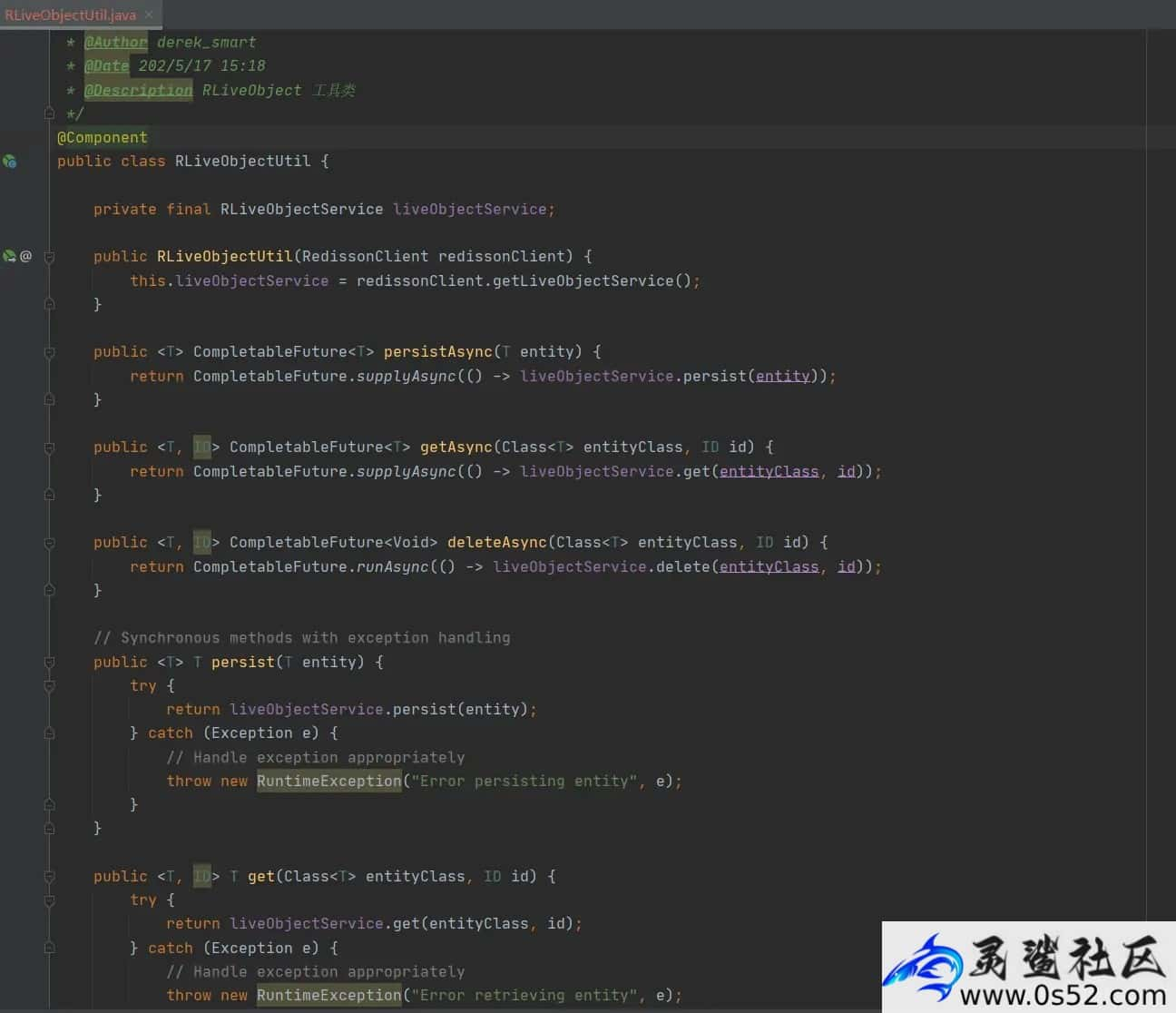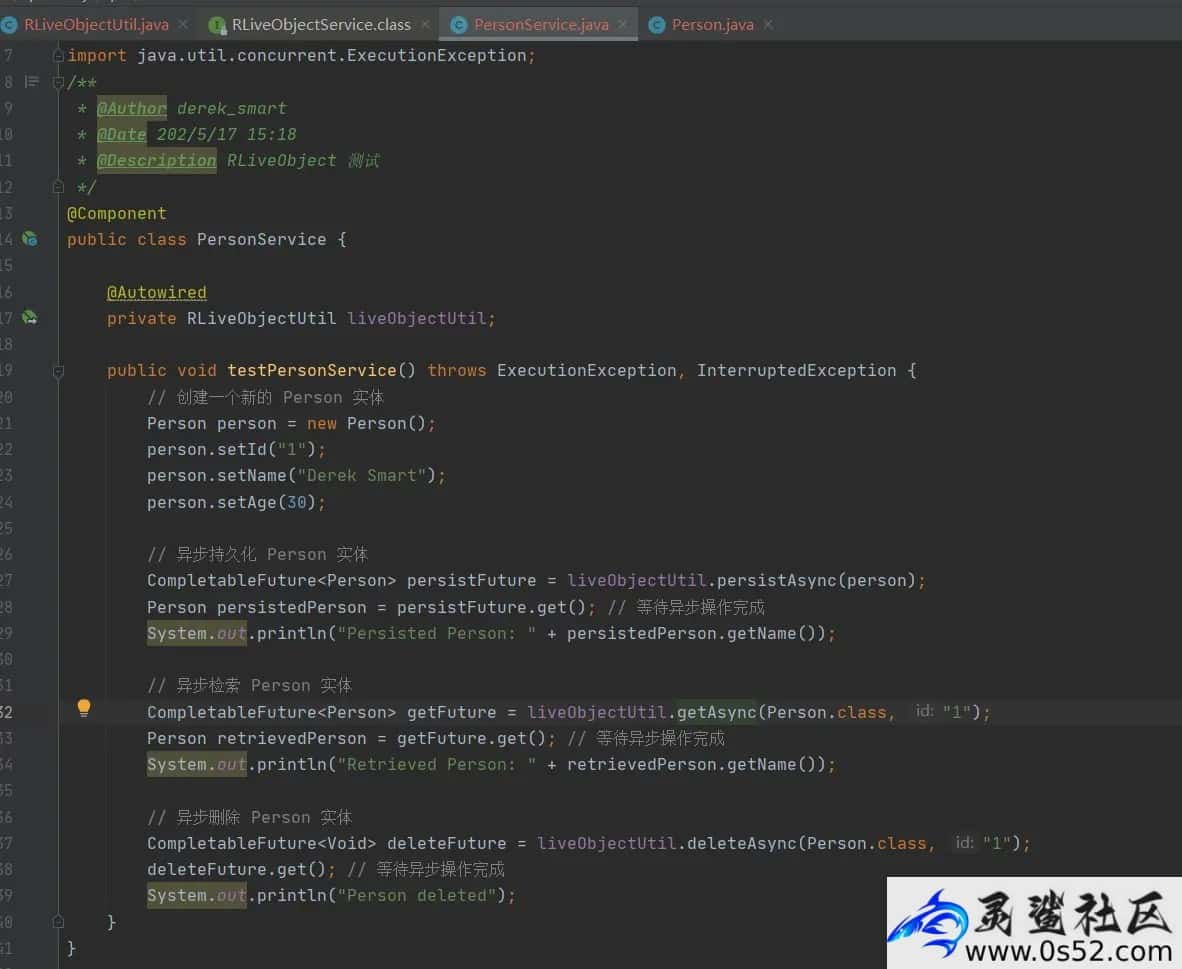探索Redission高级应用18-RLiveObject的原理,我们可以发现它是基于Redis实现的Java分布式对象存储和缓存框架。它不仅提供了丰富的分布式数据结构和服务,例如分布式锁、队列、Rate Limiter等,还允许开发者通过高层次的抽象更容易地利用Redis提供的各种功能。通过封装工具类,可以提高代码的复用性和开发效率,简化对Redis数据库的操作,使开发人员能够更便捷地进行Redis开发。在实战应用中,封装Redisson工具类需考虑到安全性、性能等方面的优化,以满足不同场景的需求。
概述:
RLiveObject 是 Redisson 提供的实时对象(Live Object)服务,属于 ORM(对象关系映射)框架。它允许将 Java 普通对象(POJO)映射到 Redis 数据结构中,使开发人员能够像操作普通 Java 对象一样操作存储在 Redis 中的数据。文章源自灵鲨社区-https://www.0s52.com/bcjc/javajc/15222.html
原理:
- 对象映射:
- RLiveObject 通过注解将 Java 对象的字段映射到 Redis 数据结构(如哈希表)中。当修改对象的字段时,RLiveObject 会自动将这些更改同步到 Redis 数据库。
- 实时操作:
- 通过 RLiveObject 服务创建或获取的对象是实时的,意味着对象字段的任何更改都会立即反映到 Redis 中,反之亦然。
- 代理实现:
- RLiveObject 在内部利用动态代理技术。当一个 RLiveObject 对象被创建或获取时,实际上是创建了一个代理对象,这个代理对象负责将操作转换为对 Redis 的操作。
- 注解配置:
- RLiveObject 使用注解来标识需要映射的类和字段,例如
@REntity标识类,@RId标识对象的唯一标识符等。
- RLiveObject 使用注解来标识需要映射的类和字段,例如
优点:
- 简化开发:
- RLiveObject 使得开发人员可以忽略底层的 Redis 命令和数据结构,直接使用 Java 对象进行编程,从而简化了开发过程。
- 实时同步:
- 对象的更改实时同步到 Redis,保证了数据的一致性。
- 减少网络传输:
- 由于操作是在对象级别进行的,因此可以减少不必要的网络传输,只有实际更改的字段会被更新到 Redis。
- 透明化:
- RLiveObject 提供了透明的对象持久化,开发人员无需关心数据如何存储和检索。
缺点:
- 性能开销:
- 动态代理和反射机制可能会引入额外的性能开销,特别是在高负载和大量操作的场景下。
- 复杂查询限制:
- 虽然 RLiveObject 提供了基本的查询功能,但对于复杂的查询操作,它可能不如直接使用 Redis 命令灵活。
- 学习曲线:
- 对于熟悉直接使用 Redis 命令的开发人员来说,需要适应 RLiveObject 的注解和 API。
- 依赖于 Redisson:
- 使用 RLiveObject 会使应用程序与 Redisson 框架紧密耦合,这可能会影响到代码的可移植性和灵活性。
- 可扩展性和自定义:
- RLiveObject 的自定义和扩展性可能有限,对于需要高度定制化的场景可能不够灵活。
使用场景:
- 快速原型开发:
- 当需要快速开发并测试一个应用程序时,RLiveObject 可以简化数据存储的过程。
- 简单 CRUD 应用:
- 对于只需要基本的创建(Create)、读取(Read)、更新(Update)、删除(Delete)操作的应用,RLiveObject 提供了一个简单直接的解决方案。
- 实时数据同步:
- 在需要实时将数据更改同步到数据库的场景中,RLiveObject 通过其实时性能提供了便利。
- 缓存实体:
- 对于需要缓存的实体对象,RLiveObject 可以自动管理 Redis 中的数据,提高数据访问速度。
- 游戏和排行榜:
- 游戏应用中的用户数据、分数和排行榜等可以使用 RLiveObject 来实现,因为它们通常涉及到频繁的读写操作
- 会话存储:
- 在 Web 应用中,可以使用 RLiveObject 来存储用户会话信息,实现会话的快速存取。
- 轻量级持久化:
- 对于不需要复杂查询和关系映射的轻量级持久化需求,RLiveObject 是一个合适的选择。
实战:
以下是一个简单的示例:文章源自灵鲨社区-https://www.0s52.com/bcjc/javajc/15222.html
1. 添加 Maven 依赖:
确保 pom.xml 文件中包含了 Redisson 和 Spring Boot 的依赖。文章源自灵鲨社区-https://www.0s52.com/bcjc/javajc/15222.html
xml文章源自灵鲨社区-https://www.0s52.com/bcjc/javajc/15222.html
<dependency>
<groupId>org.redisson</groupId>
<artifactId>redisson</artifactId>
<version>最新版本</version>
</dependency>
<dependency>
<groupId>org.springframework.boot</groupId>
<artifactId>spring-boot-starter</artifactId>
</dependency>
2. 创建 RLiveObject 实体类:
定义实体类并使用 RLiveObject 相关的注解。文章源自灵鲨社区-https://www.0s52.com/bcjc/javajc/15222.html
typescript文章源自灵鲨社区-https://www.0s52.com/bcjc/javajc/15222.html
import org.redisson.api.annotation.REntity;
import org.redisson.api.annotation.RId;
/**
* @Author derek_smart
* @Date 202/5/17 15:18
* @Description RLiveObject 测试对象类
*/
@REntity
public class Person {
@RId
private String id;
private String name;
private int age;
// Getters and Setters...
public String getId() {
return id;
}
public void setId(String id) {
this.id = id;
}
public String getName() {
return name;
}
public void setName(String name) {
this.name = name;
}
public int getAge() {
return age;
}
public void setAge(int age) {
this.age = age;
}
}
 文章源自灵鲨社区-https://www.0s52.com/bcjc/javajc/15222.html
文章源自灵鲨社区-https://www.0s52.com/bcjc/javajc/15222.html
3. 创建 RLiveObject 工具类:
封装 RLiveObjectService 的操作,提供泛型方法以支持不同类型的实体。文章源自灵鲨社区-https://www.0s52.com/bcjc/javajc/15222.html
typescript文章源自灵鲨社区-https://www.0s52.com/bcjc/javajc/15222.html
import org.redisson.api.RLiveObjectService;
import org.redisson.api.RedissonClient;
import org.springframework.stereotype.Component;
import java.util.concurrent.CompletableFuture;
import java.util.function.Supplier;
/**
* @Author derek_smart
* @Date 202/5/17 15:18
* @Description RLiveObject 工具类
*/
@Component
public class RLiveObjectUtil {
private final RLiveObjectService liveObjectService;
public RLiveObjectUtil(RedissonClient redissonClient) {
this.liveObjectService = redissonClient.getLiveObjectService();
}
public <T> CompletableFuture<T> persistAsync(T entity) {
return CompletableFuture.supplyAsync(() -> liveObjectService.persist(entity));
}
public <T, ID> CompletableFuture<T> getAsync(Class<T> entityClass, ID id) {
return CompletableFuture.supplyAsync(() -> liveObjectService.get(entityClass, id));
}
public <T, ID> CompletableFuture<Void> deleteAsync(Class<T> entityClass, ID id) {
return CompletableFuture.runAsync(() -> liveObjectService.delete(entityClass, id));
}
// Synchronous methods with exception handling
public <T> T persist(T entity) {
try {
return liveObjectService.persist(entity);
} catch (Exception e) {
// Handle exception appropriately
throw new RuntimeException("Error persisting entity", e);
}
}
public <T, ID> T get(Class<T> entityClass, ID id) {
try {
return liveObjectService.get(entityClass, id);
} catch (Exception e) {
// Handle exception appropriately
throw new RuntimeException("Error retrieving entity", e);
}
}
public <T, ID> void delete(Class<T> entityClass, ID id) {
try {
liveObjectService.delete(entityClass, id);
} catch (Exception e) {
// Handle exception appropriately
throw new RuntimeException("Error deleting entity", e);
}
}
// Utility method to handle async operations with exception handling
private <T> CompletableFuture<T> supplyAsyncWithExceptionHandling(Supplier<T> supplier) {
return CompletableFuture.supplyAsync(() -> {
try {
return supplier.get();
} catch (Exception e) {
// Handle exception appropriately
throw new RuntimeException("Error during async operation", e);
}
});
}
// Other utility methods can be added as needed...
}
 文章源自灵鲨社区-https://www.0s52.com/bcjc/javajc/15222.html
文章源自灵鲨社区-https://www.0s52.com/bcjc/javajc/15222.html
4. 配置 Redisson:
创建一个配置类,用于初始化 RedissonClient 和 RLiveObjectService。
java
import org.redisson.Redisson;
import org.redisson.api.RedissonClient;
import org.redisson.config.Config;
import org.springframework.context.annotation.Bean;
import org.springframework.context.annotation.Configuration;
@Configuration
public class RedissonConfig {
@Bean(destroyMethod = "shutdown")
public RedissonClient redissonClient() {
Config config = new Config();
// Example for single server
config.useSingleServer().setAddress("redis://127.0.0.1:6379");
// Example for cluster servers
// config.useClusterServers()
// .addNodeAddress("redis://127.0.0.1:7000", "redis://127.0.0.1:7001")
// .addNodeAddress("redis://127.0.0.1:7002");
// Example for sentinel servers
// config.useSentinelServers()
// .addSentinelAddress("redis://127.0.0.1:26379", "redis://127.0.0.1:26380")
// .setMasterName("master");
// Other configurations...
return Redisson.create(config);
}
}
5. 在 Spring 应用中使用工具类:
通过依赖注入使用 RLiveObjectUtil 类。
java
import org.springframework.beans.factory.annotation.Autowired;
import org.springframework.stereotype.Component;
import java.util.concurrent.CompletableFuture;
import java.util.concurrent.ExecutionException;
/**
* @Author derek_smart
* @Date 202/5/17 15:18
* @Description RLiveObject 测试
*/
@Component
public class PersonService {
@Autowired
private RLiveObjectUtil liveObjectUtil;
public void testPersonService() throws ExecutionException, InterruptedException {
// 创建一个新的 Person 实体
Person person = new Person();
person.setId("1");
person.setName("Derek Smart");
person.setAge(30);
// 异步持久化 Person 实体
CompletableFuture<Person> persistFuture = liveObjectUtil.persistAsync(person);
Person persistedPerson = persistFuture.get(); // 等待异步操作完成
System.out.println("Persisted Person: " + persistedPerson.getName());
// 异步检索 Person 实体
CompletableFuture<Person> getFuture = liveObjectUtil.getAsync(Person.class, "1");
Person retrievedPerson = getFuture.get(); // 等待异步操作完成
System.out.println("Retrieved Person: " + retrievedPerson.getName());
// 异步删除 Person 实体
CompletableFuture<Void> deleteFuture = liveObjectUtil.deleteAsync(Person.class, "1");
deleteFuture.get(); // 等待异步操作完成
System.out.println("Person deleted");
}
}

在上述示例中,创建了一个名为 RLiveObjectUtil 的工具类,它封装了 RLiveObjectService 的基本操作。这个类是泛型的,允许使用任何 RLiveObject 实体。通过在 Spring 服务中注入 RLiveObjectUtil,可以轻松地对实体进行持久化、检索和删除操作。
- 异步支持:为每个方法提供异步版本,这些方法将返回
CompletableFuture,允许在不阻塞当前线程的情况下执行操作。
- 异常处理:在每个方法中添加异常处理逻辑,以确保在 Redis 操作失败时能够适当地处理异常。
- 线程安全确保工具类在多线程环境中是线程安全的。 - 提供异常处理,以便在操作 Redis 时更加健壮。
- 使用泛型方法减少代码重复,并提高代码的可读性和可维护性。
- 在配置类中添加更多的配置选项,以支持不同的 Redis 运行模式。
总结:
RLiveObject 是 Redisson 提供的高级功能,适合于需要快速开发且数据模型较简单的应用。在决定使用 RLiveObject 时,应考虑其带来的便利与潜在的性能成本。


评论